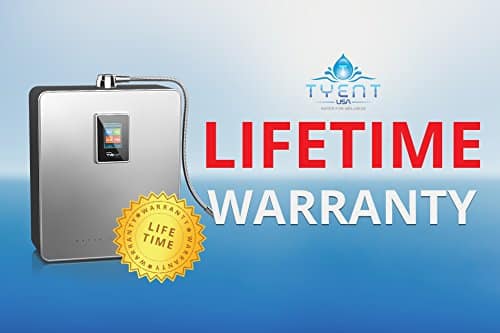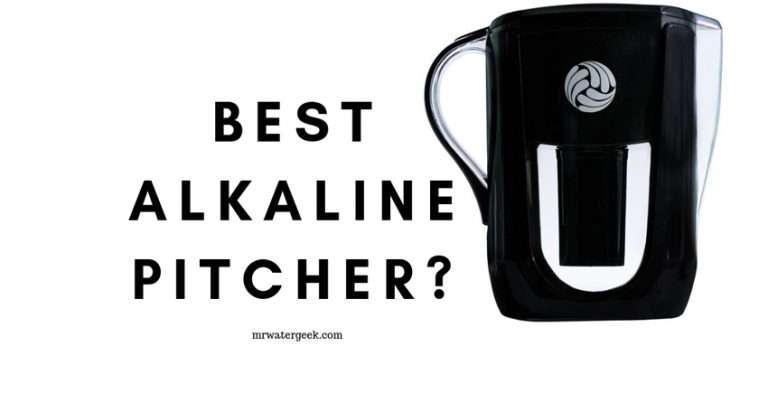pH of Water: What are the SERIOUS RISKS and Benefits?
 pH of Water Risks
pH of Water Risks
Regularly drinking alkaline water is generally considered safe for most people, but there are some potential risks and considerations.
![]() For instance, the Environmental Protection Agency (EPA) warns that drinking an excessive level of acidic water can be dangerous. This is because they say that water should have a pH of 6.5-8.5 in order to be within EPA standards.
For instance, the Environmental Protection Agency (EPA) warns that drinking an excessive level of acidic water can be dangerous. This is because they say that water should have a pH of 6.5-8.5 in order to be within EPA standards.
You should also note that even water in the acceptable pH range that has a slightly high or low pH level may taste weird to the average person.
![]() High pH water (alkaline) feels slippery and some people say it tastes of baking soda. Also, according to the EPA website high alkaline water may leave deposits on home appliances.
High pH water (alkaline) feels slippery and some people say it tastes of baking soda. Also, according to the EPA website high alkaline water may leave deposits on home appliances.
![]() Low pH water (acidic), on the other hand, may give you a metallic or bitter taste.
Low pH water (acidic), on the other hand, may give you a metallic or bitter taste.
![]() Altered Stomach pH: Alkaline water can temporarily raise the pH of the stomach, potentially impacting digestion. It may interfere with the natural acidity needed for proper breakdown of food.
Altered Stomach pH: Alkaline water can temporarily raise the pH of the stomach, potentially impacting digestion. It may interfere with the natural acidity needed for proper breakdown of food.
![]() Gastrointestinal Issues: Some individuals may experience gastrointestinal issues, such as nausea or vomiting, due to the altered pH levels in the stomach.
Gastrointestinal Issues: Some individuals may experience gastrointestinal issues, such as nausea or vomiting, due to the altered pH levels in the stomach.
 pH of Water Benefits
pH of Water Benefits
 While the ideal pH of drinking water should be between 6-8.5, the human body maintains the pH balance constantly and is not affected by water consumption.
While the ideal pH of drinking water should be between 6-8.5, the human body maintains the pH balance constantly and is not affected by water consumption.
For example, our stomachs have a naturally low pH of 2, which is a beneficial acid that helps us digest food.
Despite the small (but growing) amount of proven scientific research, advocates of alkaline water believe it has the potential for many health benefits. They show that slightly alkaline water also has other advantages:
Support of the immune system.
Helps in with chronic illnesses.
Potential colon cleansing properties.
It adds moisture to skin health and other detoxifying properties.
Anti-aging properties (this is due to liquid antioxidants that can be absorbed by the body in a quicker fashion).
What is pH of Water?
PH is a measure of electrically charged particles in a substance. The letters “pH” describe the quality of drinking water in terms of whether it is acidic or alkaline.
 Knowing this helps us to indicate how acidic or alkaline a substance is and the pH scale goes from 0 to 14.
Knowing this helps us to indicate how acidic or alkaline a substance is and the pH scale goes from 0 to 14.
Acidic water is reflected with a number below 7. Unsurprisingly, a pH of 0 indicates the most acidic substance, for instance, the acid in batteries goes under this category.
Getting alkaline water means that the water is a pH of 8 or higher. The most alkaline substance is something like bleach which has a pH of 14.
Pure water has a pH of 7 and is considered “neutral” because it has no acidic qualities.
Drinking Water pH Level Chart
| Water Type | pH level |
| Tap water | Typically 7.5 (but varies) |
| Reverse Osmosis / Distilled Water | 5 to 7 |
| Bottled Water | 6.5 to 7.5 |
| Waters labeled “Alkaline” | 8 to 9 |
| Ocean Water | About 8 |
| Acid rain | 5 to 5.5 |
Which pH Value is Safe for Drinking Water?
The EPA (United States Environmental Protection Agency) is responsible for keeping an eye on the quality of water consumed by the US population.
The pH level of drinking water is not something that the EPA regulates. This is because they consider this to be an “aesthetic quality” of water.
However, they do recommend that all water that comes under municipal drinking water are within the pH range of of 6.5 to 8.5.
What Is An Unsafe pH Water Level?
The pH of freshwater varies greatly as it depends on a number of different factors like natural processes, human activity and weather conditions.
 However, water that has a very high or low level of pH can indicate some type of heavy metal or chemical contamination.
However, water that has a very high or low level of pH can indicate some type of heavy metal or chemical contamination.
The “safe” pH level is between 6.5 to 8.5.
However, water that does not fall within this specified range (especially if it is alkaline water) does not necessarily mean that it is hazardous.
This is despite the fact that extremely alkaline water can sometimes have an unpleasant taste or odor.
![]() The ‘Unsafe Level pH Level of Water’ Is Usually Under 6.5
The ‘Unsafe Level pH Level of Water’ Is Usually Under 6.5
On the other hand, acidic water with a pH that is under 6.5 is likely to have contaminants. This can severely endanger drinking and may even corrode (dissolve) metal pipes.
This is the reason why most municipal water suppliers voluntarily test the level of alkalinity of water because they know it’s an important way to monitor contamination.
Why is Alkaline Water A Popular New Trend?
Alkaline water is a popular choice in recent years. This is because many people claim that drinking slightly alkaline water with a pH level of between 8 and 9 can improve health.
 Some claims suggest that it can make you age more slowly, maintains a healthy pH in your body and help with chronic diseases.
Some claims suggest that it can make you age more slowly, maintains a healthy pH in your body and help with chronic diseases.
Despite the many health claims by consumers and sellers of alkaline water, there is only a small amount of scientific evidence that alkaline water is healthier than other types of drinking water.
However, the important thing to note is that all studies agree on one thing: Alkaline water is NOT harmful to your health.
So if you have the money then it may be worth investing in an alkaline machine and enjoy from the possible health benefits that it may provide.
Testing pH Water Level at Home
Municipal water companies normally make sure that the water they supply is at a pH of about 7. This means that you probably don’t need to do a home pH test.
 However, if you notice some problems then you may want to double-check.
However, if you notice some problems then you may want to double-check.
For instance, if you see that your pipes and faucets have turned blue, white or red then you should probably raise the alarm.
This is because this type of discoloration or a weird color of your tap water can be a sign of acidic corrosion by acidic water.
If your pipes are corroded then they should be inspected by a qualified professional plumber and replaced if necessary.
Before you call the plumber make sure you do a pH test to make sure you can provide them with the right information before they turn up.
 It is actually very easy and cheap to test the pH level of your drinking water at home. All you need is a home pH test kit and these come in many different types at different price points.
It is actually very easy and cheap to test the pH level of your drinking water at home. All you need is a home pH test kit and these come in many different types at different price points.
Some of the best rated alkaline test products are test strips that check the water quality. Just dip the strip into a sample of your drinking water, wait a few minutes and then you will get an accurate measurement.
PH Demo: Tyent Alkaline Water Ionizers vs Bottled Water Brands
The Best Way to Get Alkaline Water?
The Tyent UCE-13 PLUS Alkaline Water Ionizer is an easy-to-use alkaline water machine.
 Simply connect it to your current kitchen sink and immediately drink alkaline water.
Simply connect it to your current kitchen sink and immediately drink alkaline water.
It also comes with a filter. This means that it has a dual purpose of removing contaminants while preserving / adding healthy minerals.

In addition to cleaning, the alkaline water machine provides acidic water for cleaning, alkaline drinking water and many other options.
Better Features:
The device is very small but powerful with a ridiculously long list of functions, but here are some of its features:
- It is very easy to use, install and configure.
- The device has a bright LCD screen that is programmable.

- The actual machine goes under the counter so you just use the touch screen tap to access water.
- Oh, and did I mention that it contains voice messages that will guide you?
- There are 35 preset modes.
- The device has a pH value between 1.7 and 12.5

- The high price is justified by the fact that it is designed for a long life. With durable panels and durable exterior.
- There is also a lifetime guarantee forever if things are not quite right.
**UPDATE: This Offer Ends Soon**Buy ANY Tyent Alkaline machine and get over $1600 worth of FREE Gifts, shipping, upgrades and shower head. Just use the coupon code: WaterGeek.






